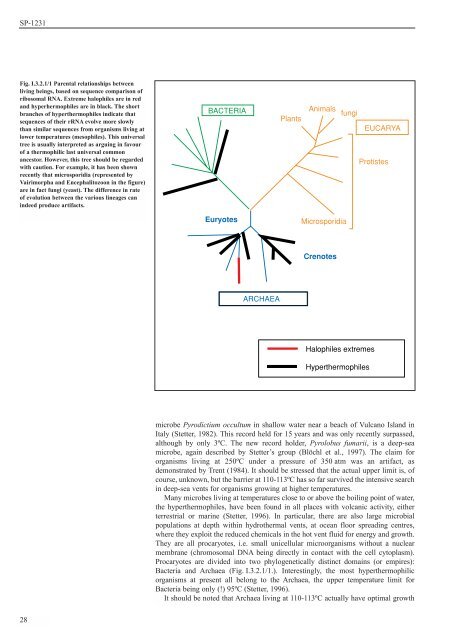Exobiology in the Solar System & The Search for Life on Mars - ESA
Exobiology in the Solar System & The Search for Life on Mars - ESA
Exobiology in the Solar System & The Search for Life on Mars - ESA
You also want an ePaper? Increase the reach of your titles
YUMPU automatically turns print PDFs into web optimized ePapers that Google loves.
SP-1231<br />
Fig. I.3.2.1/1 Parental relati<strong>on</strong>ships between<br />
liv<str<strong>on</strong>g>in</str<strong>on</strong>g>g be<str<strong>on</strong>g>in</str<strong>on</strong>g>gs, based <strong>on</strong> sequence comparis<strong>on</strong> of<br />
ribosomal RNA. Extreme halophiles are <str<strong>on</strong>g>in</str<strong>on</strong>g> red<br />
and hyperhermophiles are <str<strong>on</strong>g>in</str<strong>on</strong>g> black. <str<strong>on</strong>g>The</str<strong>on</strong>g> short<br />
branches of hyper<str<strong>on</strong>g>the</str<strong>on</strong>g>rmophiles <str<strong>on</strong>g>in</str<strong>on</strong>g>dicate that<br />
sequences of <str<strong>on</strong>g>the</str<strong>on</strong>g>ir rRNA evolve more slowly<br />
than similar sequences from organisms liv<str<strong>on</strong>g>in</str<strong>on</strong>g>g at<br />
lower temperatures (mesophiles). This universal<br />
tree is usually <str<strong>on</strong>g>in</str<strong>on</strong>g>terpreted as argu<str<strong>on</strong>g>in</str<strong>on</strong>g>g <str<strong>on</strong>g>in</str<strong>on</strong>g> favour<br />
of a <str<strong>on</strong>g>the</str<strong>on</strong>g>rmophilic last universal comm<strong>on</strong><br />
ancestor. However, this tree should be regarded<br />
with cauti<strong>on</strong>. For example, it has been shown<br />
recently that microsporidia (represented by<br />
Vairimorpha and Encephalitozo<strong>on</strong> <str<strong>on</strong>g>in</str<strong>on</strong>g> <str<strong>on</strong>g>the</str<strong>on</strong>g> figure)<br />
are <str<strong>on</strong>g>in</str<strong>on</strong>g> fact fungi (yeast). <str<strong>on</strong>g>The</str<strong>on</strong>g> difference <str<strong>on</strong>g>in</str<strong>on</strong>g> rate<br />
of evoluti<strong>on</strong> between <str<strong>on</strong>g>the</str<strong>on</strong>g> various l<str<strong>on</strong>g>in</str<strong>on</strong>g>eages can<br />
<str<strong>on</strong>g>in</str<strong>on</strong>g>deed produce artifacts.<br />
28<br />
BACTERIA<br />
Euryotes<br />
ARCHAEA<br />
Plants<br />
Animals fungi<br />
Microsporidia<br />
Crenotes<br />
EUCARYA<br />
Protistes<br />
Halophiles extremes<br />
Hyper<str<strong>on</strong>g>the</str<strong>on</strong>g>rmophiles<br />
microbe Pyrodictium occultum <str<strong>on</strong>g>in</str<strong>on</strong>g> shallow water near a beach of Vulcano Island <str<strong>on</strong>g>in</str<strong>on</strong>g><br />
Italy (Stetter, 1982). This record held <str<strong>on</strong>g>for</str<strong>on</strong>g> 15 years and was <strong>on</strong>ly recently surpassed,<br />
although by <strong>on</strong>ly 3ºC. <str<strong>on</strong>g>The</str<strong>on</strong>g> new record holder, Pyrolobus fumarii, is a deep-sea<br />
microbe, aga<str<strong>on</strong>g>in</str<strong>on</strong>g> described by Stetter’s group (Blöchl et al., 1997). <str<strong>on</strong>g>The</str<strong>on</strong>g> claim <str<strong>on</strong>g>for</str<strong>on</strong>g><br />
organisms liv<str<strong>on</strong>g>in</str<strong>on</strong>g>g at 250ºC under a pressure of 350 atm was an artifact, as<br />
dem<strong>on</strong>strated by Trent (1984). It should be stressed that <str<strong>on</strong>g>the</str<strong>on</strong>g> actual upper limit is, of<br />
course, unknown, but <str<strong>on</strong>g>the</str<strong>on</strong>g> barrier at 110-113ºC has so far survived <str<strong>on</strong>g>the</str<strong>on</strong>g> <str<strong>on</strong>g>in</str<strong>on</strong>g>tensive search<br />
<str<strong>on</strong>g>in</str<strong>on</strong>g> deep-sea vents <str<strong>on</strong>g>for</str<strong>on</strong>g> organisms grow<str<strong>on</strong>g>in</str<strong>on</strong>g>g at higher temperatures.<br />
Many microbes liv<str<strong>on</strong>g>in</str<strong>on</strong>g>g at temperatures close to or above <str<strong>on</strong>g>the</str<strong>on</strong>g> boil<str<strong>on</strong>g>in</str<strong>on</strong>g>g po<str<strong>on</strong>g>in</str<strong>on</strong>g>t of water,<br />
<str<strong>on</strong>g>the</str<strong>on</strong>g> hyper<str<strong>on</strong>g>the</str<strong>on</strong>g>rmophiles, have been found <str<strong>on</strong>g>in</str<strong>on</strong>g> all places with volcanic activity, ei<str<strong>on</strong>g>the</str<strong>on</strong>g>r<br />
terrestrial or mar<str<strong>on</strong>g>in</str<strong>on</strong>g>e (Stetter, 1996). In particular, <str<strong>on</strong>g>the</str<strong>on</strong>g>re are also large microbial<br />
populati<strong>on</strong>s at depth with<str<strong>on</strong>g>in</str<strong>on</strong>g> hydro<str<strong>on</strong>g>the</str<strong>on</strong>g>rmal vents, at ocean floor spread<str<strong>on</strong>g>in</str<strong>on</strong>g>g centres,<br />
where <str<strong>on</strong>g>the</str<strong>on</strong>g>y exploit <str<strong>on</strong>g>the</str<strong>on</strong>g> reduced chemicals <str<strong>on</strong>g>in</str<strong>on</strong>g> <str<strong>on</strong>g>the</str<strong>on</strong>g> hot vent fluid <str<strong>on</strong>g>for</str<strong>on</strong>g> energy and growth.<br />
<str<strong>on</strong>g>The</str<strong>on</strong>g>y are all procaryotes, i.e. small unicellular microorganisms without a nuclear<br />
membrane (chromosomal DNA be<str<strong>on</strong>g>in</str<strong>on</strong>g>g directly <str<strong>on</strong>g>in</str<strong>on</strong>g> c<strong>on</strong>tact with <str<strong>on</strong>g>the</str<strong>on</strong>g> cell cytoplasm).<br />
Procaryotes are divided <str<strong>on</strong>g>in</str<strong>on</strong>g>to two phylogenetically dist<str<strong>on</strong>g>in</str<strong>on</strong>g>ct doma<str<strong>on</strong>g>in</str<strong>on</strong>g>s (or empires):<br />
Bacteria and Archaea (Fig. I.3.2.1/1.). Interest<str<strong>on</strong>g>in</str<strong>on</strong>g>gly, <str<strong>on</strong>g>the</str<strong>on</strong>g> most hyper<str<strong>on</strong>g>the</str<strong>on</strong>g>rmophilic<br />
organisms at present all bel<strong>on</strong>g to <str<strong>on</strong>g>the</str<strong>on</strong>g> Archaea, <str<strong>on</strong>g>the</str<strong>on</strong>g> upper temperature limit <str<strong>on</strong>g>for</str<strong>on</strong>g><br />
Bacteria be<str<strong>on</strong>g>in</str<strong>on</strong>g>g <strong>on</strong>ly (!) 95ºC (Stetter, 1996).<br />
It should be noted that Archaea liv<str<strong>on</strong>g>in</str<strong>on</strong>g>g at 110-113ºC actually have optimal growth

















